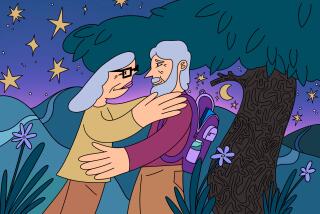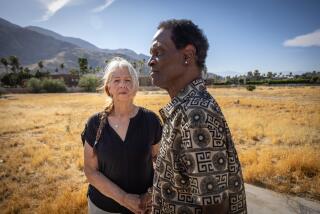Scouring Laguna for Leary’s Legend
I must have been a senior in high school the first time I saw Timothy Leary.
It was 1966, and my friend Tony and I drove to the Santa Monica Civic Auditorium, where the great acid guru -- the man who popularized LSD and inspired a generation of hippies to “Turn On, Tune In, Drop Out” -- was making an appearance. I recall it vividly because Tony told me halfway there that he’d ingested some of Leary’s favorite drug before we’d started and he was imagining the car spinning round and round in glitter as he drove. It was the first time I ever feared for my life.
Leary was resplendent in garlands and a long, white robe, sitting in a lotus position at center stage surrounded by worshiping fans with long hair and beads as he narrated a jerky light show on a screen behind him. We closed our eyes and let him draw us into his powerful world of cosmic relevance and fantasy. The experience remains etched in memory as the first of many times over the next half-decade I would feel a strange twinge of anticipation and fear, a daunting quality of lightness and awe that, for me, came to represent the late ‘60s and early ‘70s.
I thought about it all recently as I began my search for the notorious caves of Laguna Beach once frequented, legend has it, by Leary and his flock. It would take me in surprising directions: from buried secrets of the past to the closeted vestiges of that history in the present. Like any good search, it begins with the tale of a survivor, of someone who’d been there.
Neal Purcell’s claim to fame is that he’s the guy who arrested Leary for possession of marijuana and made it stick. It happened in 1968, when Purcell was a rookie Laguna Beach patrolman. He went on to become the city’s police chief. Now retired, he is filling in as interim chief of Anderson, a small Northern California town where I caught up with him by phone.
“It was an accident,” Purcell said of the highly publicized arrest Dec. 26th, two years after the former Harvard psychology professor, fired for experimenting with psychedelic drugs, had immigrated to the West Coast. “I was just out on patrol about 11 p.m.,” he recalled. “I turned into Woodland Drive and saw a car heading out that was stopped in the middle of the street.”
Inside were Leary, who was renting a small house off Laguna Canyon Road, his wife, Rosemary, and his teenage son, John. There was lots of marijuana and hashish in the car, Purcell said -- mostly in Rosemary’s fur bag and sewn into little pouches in John’s shirt.
Purcell arrested all three for possession. Though neither realized it at the time, it was a turning point in both their lives. The bust made Purcell famous and eventually sent Leary, who already was infamous, to prison on a 10-year term. While serving that sentence, the “high priest of LSD” escaped from the California Men’s Colony at San Luis Obispo and ended up in Afghanistan, where he spent several years before being recaptured in 1973.
In the late 1960s, though, Leary was Laguna’s (and the nation’s) patron sprite of hippies and a controversial figure whom locals saw, depending on their sensibilities, either as a poetic visionary or a self-centered dope pusher preying on kids.
Purcell leaned decidedly toward the latter view.
“He used to hang out with a group called the Brotherhood of Eternal Love,” he said. “They’d get loaded, go up to those caves and maybe spend a couple of nights up there chanting to the moon. Whoever wanted to could follow Leary up.”
Ah, those legendary caves of Leary. For years, Purcell told me, one was marked by a peace symbol with the guru’s name etched high in a wall. “Can you tell me how to find them?” I gingerly inquired. He gave me directions. But they were vague; more useful, perhaps, to someone who’d been there before. I decided to inquire further.
My next stop was a guy who claimed to have known Leary, said he used to sell drugs for the Brotherhood and now described himself as a “devout Christian and Jerry Falwell Republican” who is convinced that the hippie scene was a terrible con. It was he who told me about Mystic Arts, the infamous “head shop” on South Coast Highway where the drug guru and his followers reportedly gathered. The place was torched in 1970 under mysterious circumstances believed by many Laguna hippies to have been orchestrated by forces in the community opposed to their existence. Even in 2003, rumors of its unseemly demise circulate among the once-faithful.”If you pull up the tiles you can still see the smoke stains,” said Moe Raisdana, owner of the Nina Rug Gallery where once rolling papers, water pipes and incense were featured wares of the Mystic Arts shop. Now the rug store is closing.
A few days later, my fantasies are confirmed.
In 1968, Kent Kelley managed Mystic Arts and times have hardly changed. Today at 55, he still has shoulder-length hair -- albeit graying -- and owns Blind Faith, an “automatic eclectic emporium boutique.”
Kelley loves talking about the old days, when his shop was “the quintessential head shop” complete with organic food, metaphysical art and the obligatory meditation room with the fireplace in back. “People came from all over the world, and Leary would be there every day,” he said. “It was one of his frequent stops. The last time I talked to him, [in 1995 shortly before his death in 1996 of cancer] he mentioned the shop and how it had been the real thing.”
Then Kelley gives me a present -- directions to Leary’s house.
Woodland Drive, I soon discover, isn’t what it used to be. Once a ramshackle haven for renegade hippies and drug dealers, it is now clean, suburban, pricey.
A peek into one backyard seems almost a glance back in time. There, set against a sheer cliff, the canyon basks in a convergence of greenery and sky.
It’s not much of a stretch to imagine an extended family of longhairs -- perhaps Leary among them -- lounging in the sun of a summer afternoon. I pause to savor the moment, then start knocking on doors. The third one is gold.
“A lot of people have told me that Leary lived here, and I believe them,” says the woman behind it. “There’s definitely some trippy energy here.”
The aging cottage is small and gray with pink trim. I imagine flowers in its windows. I picture paisleys on its walls.
“It’s definitely cool that he lived here,” she says. “That whole era was unique; you can’t coordinate what’s happening today with what was going on then.”
Suddenly, the moment is over. She’d like to ask me in, says the woman who prefers to remain anonymous, but she’s way too busy -- perhaps another time. Yes, she remembers some caves -- one had a couch in it, she recalls. She tells me roughly how to get there. I set out, confident my search will soon be rewarded.
Finding them, however, proves challenging. I now have several sets of directions from people claiming to have seen them; although they overlap, no two are the same. I drive out Laguna Canyon Road, seeking a trail that supposedly starts somewhere around Big Bend Drive. Not finding it, I drive to the end of a street called Canyon Acres Drive to try the trail there. It turns out to be the walkway to a long-abandoned house rambling about a hundred yards up the hill to a dead end. I decide that, instead of hiking up, I will try to climb down.
I drive up Park Street, past Top of the World Drive, and turn left on Alta Laguna Boulevard. From a parking lot there, the view stretches for miles. I follow yet another set of instructions in search of a dirt path meandering toward the sea. I feel a sinking in my chest as I notice a myriad of paths crisscrossing to the lip of the canyon.
I pause, arbitrarily picking one, and walk a bit farther, then choose another way, crossing and then retracing my steps. Finally, I reach a boulder overlooking Laguna Canyon Road snaking toward the sparkling ocean beyond. I stop, listening, trying to feel what Leary must have felt. I hear only the whistling wind before slowly walking to my car.
I saw Leary once more before his death of prostate cancer. It was probably in the late 1980s, long after I had become a drug-eschewing parent. By then, Leary was making a living any way he could, including a brief stint as a stand-up comedian. The performance at Long Beach Community College was attended by erstwhile hippies like myself come to see a fallen idol, and youngsters curiously regarding this quaint figure from the past.
He seemed a caricature of what he’d been and all he’d seen. The audience was polite but mildly embarrassed. It dawned on me then, as it does now in Laguna Canyon, that Leary the man doesn’t matter. What matters is Leary the myth, the figment of a generation’s imagination, a link to the exuberance and folly of our youth. Timothy Leary illuminated a colorful moment in time, shining his own special light on some of that era’s stranger hues.
Like those caves, his legacy is elusive. It seems somehow right that I will never find them.
More to Read
Sign up for The Wild
We’ll help you find the best places to hike, bike and run, as well as the perfect silent spots for meditation and yoga.
You may occasionally receive promotional content from the Los Angeles Times.






